This chapter presents an updated global assessment of food security and nutrition up to the year 2023 and a report on progress towards meeting SDG Targets 2.1 and 2.2 – ending hunger and ensuring access to safe, nutritious and sufficient food for all people all year round and eradicating all forms of malnutrition by 2030.
Section 2.1 presents an updated assessment of the state of food security and progress towards achieving the hunger and food insecurity target (SDG Target 2.1). It includes global, regional and subregional estimates of the two SDG Target 2.1 indicators updated to 2023: the prevalence of undernourishment (PoU) and the prevalence of moderate or severe food insecurity based on the Food Insecurity Experience Scale (FIES). Updated global and regional estimates of the prevalence of food insecurity by sex and by degree of urbanization are also provided. Section 2.2 presents improved estimates of the cost and of the affordability of a healthy diet, covering 2017 to 2022, contributing information about economic access to diverse, nutritious foods globally. This year’s assessment reflects the latest food price data released by the International Comparison Program (ICP) and the methodological refinements to improve the estimates of affordability. Section 2.3 presents analyses of the state of nutrition in the world and progress towards the global nutrition targets that were defined by the World Health Assembly (WHA) in 2012 and the 2030 Agenda for Sustainable Development (SDG Target 2.2). Updates are provided this year for exclusive breastfeeding and adult obesity. The section also includes spotlights on progress in the least developed countries and on the double burden of malnutrition.
2.1 Food security indicators – latest updates and progress towards ending hunger and ensuring food security
- ➔ After rising sharply from 2019 to 2021, global hunger, measured by the prevalence of undernourishment (PoU), has persisted at nearly the same level for three consecutive years, still affecting 9.1 percent of the population in 2023 compared with 7.5 percent in 2019.
- ➔ It is estimated that between 713 and 757 million people, corresponding to 8.9 and 9.4 percent of the global population, respectively, may have faced hunger in 2023. Considering the mid-range (733 million), this is about 152 million more people than in 2019.
- ➔ Trends at the regional level differ considerably. While hunger is still on the rise in Africa, it has remained relatively unchanged in Asia, and there is notable progress in Latin America. From 2022 to 2023, hunger increased in Western Asia, the Caribbean and in most subregions of Africa.
- ➔ Africa remains the region with the largest estimated proportion of the population facing hunger – 20.4 percent, compared with 8.1 percent in Asia, 6.2 percent in Latin America and the Caribbean, and 7.3 percent in Oceania. However, Asia is still home to more than half of all those facing hunger in the world, about 385 million people. Hunger also affected almost 300 million people in Africa, over 40 million in Latin America and the Caribbean, and more than 3 million in Oceania in 2023.
- ➔ It is projected that 582 million people will be chronically undernourished at the end of the decade and that more than half of them will be in Africa. This is about 130 million more undernourished people than in a scenario reflecting the world economy before the COVID-19 pandemic.
- ➔ Going beyond hunger, the prevalence of moderate or severe food insecurity remains above pre-pandemic levels, with little change in four years. In 2023, an estimated 28.9 percent of the global population – 2.33 billion people – were moderately or severely food insecure, meaning they did not have regular access to adequate food. These estimates include 10.7 percent of the population – 864 million people – who were food insecure at severe levels, posing grave risks to their health and well-being.
- ➔ In 2023, the prevalence of moderate or severe food insecurity in Africa (58.0 percent) was nearly double the global average, whereas in Asia, Latin America and the Caribbean, and Oceania, the prevalence is closer to the global estimate – 24.8, 28.2 and 26.8 percent, respectively.
- ➔ The prevalence of moderate or severe food insecurity remained virtually unchanged in Africa, Asia, and Northern America and Europe from 2022 to 2023, and it worsened in Oceania. In contrast, notable progress occurred in Latin America.
- ➔ Food insecurity affects women more than men, although the gender gap, which widened sharply from 2019 to 2021, began to narrow in 2022 and continued to grow smaller in 2023. Globally, the percentage-point difference in the prevalence of moderate or severe food insecurity between men and women fell from 3.6 in 2021 to 2.3 in 2022 and narrowed further to 1.3 in 2023.
- ➔ Globally and in all regions except Northern America and Europe, the prevalence of food insecurity is consistently higher in rural areas than in urban areas, while the prevalence in peri-urban areas compared to rural areas differs among regions.
SDG Indicator 2.1.1 Prevalence of undernourishment
The assessment of global hunger in 2023, measured by the prevalence of undernourishment (PoU) (SDG Indicator 2.1.1), reveals a continuing lack of progress towards the goal of Zero Hunger. Inflationary pressures, in particular increases in the relative prices of food, continue to erode economic gains for many people’s access to food in many countries, as the world is still struggling to recover from the global pandemic, hampered by a growing number of conflicts and extreme weather events.
After rising sharply from 2019 to 2021, the proportion of the world population facing hunger persisted at virtually the same level for three consecutive years, with the latest estimates indicating a global PoU of 9.1 percent in 2023 (Figure 1) (see Box 1). In terms of population, between about 713 and 757 million people (8.9 and 9.4 percent of the global population, respectively) were estimated to be undernourished in 2023. Considering the mid-range estimate (733 million), about 152 million more people may have faced hunger in 2023 compared to 2019.
FIGURE 1 Global hunger rose sharply from 2019 to 2021 and persisted at the same level to 2023
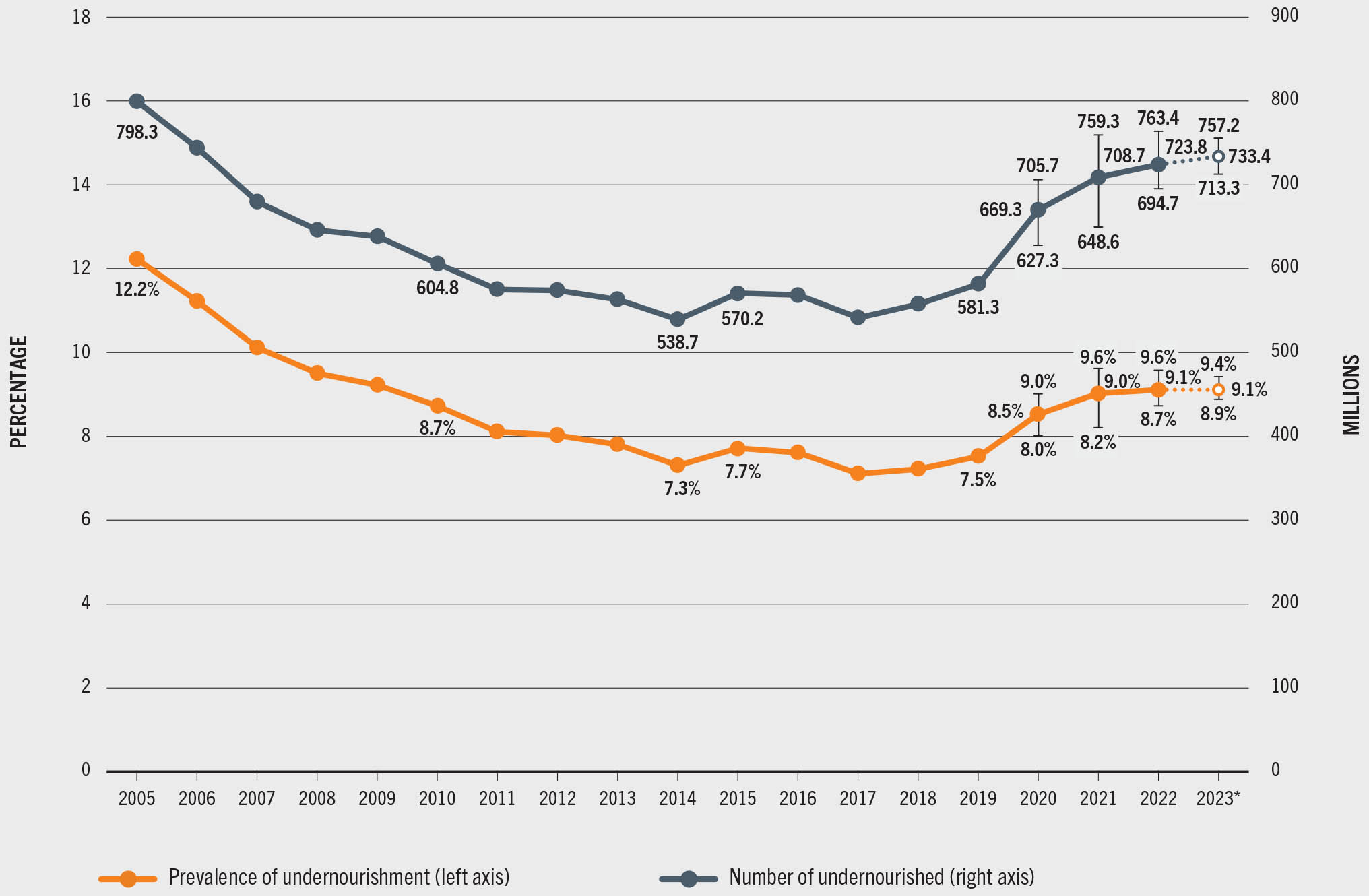
SOURCE: FAO. 2024. FAOSTAT: Suite of Food Security Indicators. [Accessed on 24 July 2024]. https://www.fao.org/faostat/en/#data/FS. Licence: CC-BY-4.0.
BOX 1Updates in the series of prevalence of undernourishment estimates
As in every edition of this report, rather than just adding a new data point to the existing series, the entire series of prevalence of undernourishment (PoU) estimates from 2000 has been revised to reflect revised or additional data and information FAO has received since last year’s publication. In some cases, the new information pertains to past years, a reason why the entire series must be revised, and readers are urged to avoid comparing figures across different editions of the report.
In this edition, the major revision entailed reflecting revised estimates of the degree of inequality in food access within national populations, as captured by the coefficient of variation due to income (CV|y) parameter that enters into the formula to compute the PoU. Since the last edition of this report, FAO’s Statistics Division has gained access to the full microdata sets of 14 surveys from 13 countries, which have been processed to update the CV|y for the following country/year combinations: Armenia (2022), Costa Rica (2019), Côte d’Ivoire (2022), India (2011/12 and 2022/23), Jordan (2017), Kazakhstan (2022), Maldives (2016), Mali (2022), Mexico (2022), Niger (2022), Republic of Moldova (2022), Senegal (2022) and Timor-Leste (2015).
The newly estimated CV|y parameters replaced previous values for those countries and years, which may have been based on interpolation or on modelling. This often also requires a revision of the same parameter in the same country for the preceding and subsequent years, in order to reconcile the old and the new information through consistent interpolations and extrapolations (see Annex 1B).
In addition to the revision of the PoU series for the countries where new survey data are available and the corresponding revisions of the underlying regional and global aggregates, one very visible effect of the availability of new data from nine surveys conducted after 2021 is the reduction in the uncertainty that surrounds the estimates of the PoU for 2022 and 2023. This is so, given the introduction in the analysis of direct evidence on the degree of inequality in food access for those countries. In previous editions of this report, the relatively higher level of uncertainty induced by the lack of national data to reflect the effects of the pandemic resulted in the need to introduce upper and lower bounds to the series in 2020, 2021 and 2022 (see Supplementary material to Chapter 2). While the uncertainty around what the real situation was in those years will never disappear, we hope that access to more frequent information on food consumption from more countries will continue to be available in the future, to make our assessments of the state of food insecurity in the world always more reliable.
Africa is the region with the largest PoU – 20.4 percent, compared with 8.1 percent in Asia, 6.2 percent in Latin America and the Caribbean, and 7.3 percent in Oceania (Table 1). However, Asia is still home to the largest number: 384.5 million, or more than half of all those facing hunger in the world. In Africa, 298.4 million people may have faced hunger in 2023, compared with 41.0 million in Latin America and the Caribbean and 3.3 million in Oceania (Table 2).
TABLE 1Prevalence of undernourishment, 2005–2023
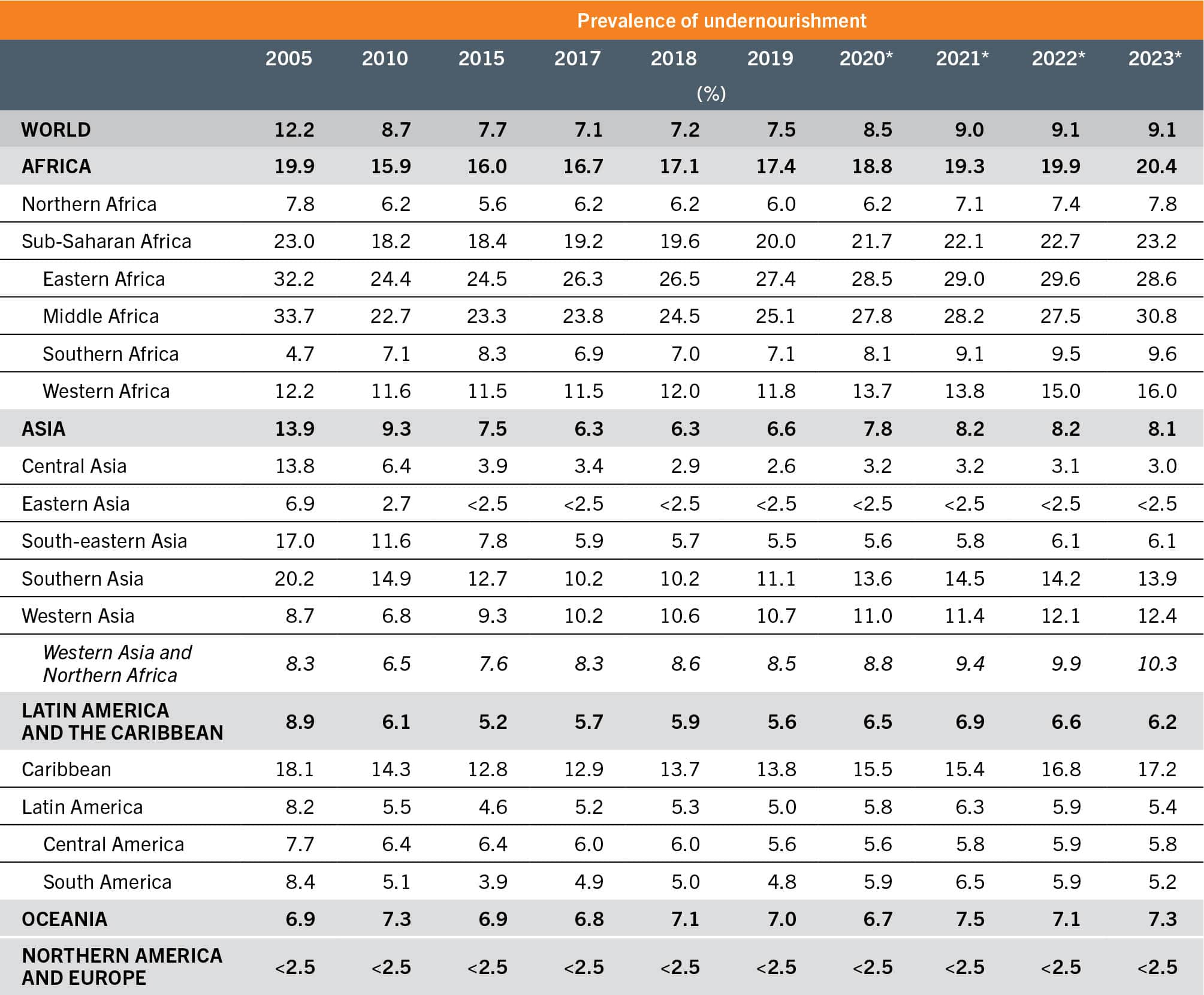
SOURCE: FAO. 2024. FAOSTAT: Suite of Food Security Indicators. [Accessed on 24 July 2024]. https://www.fao.org/faostat/en/#data/FS. Licence: CC-BY-4.0.
While there was no change in the prevalence of hunger at the global level, the trends across and within regions varied. The PoU for Africa increased continuously from 2015 to 2023, whereas hunger has been on the decline in Latin America and the Caribbean since 2021 and remained relatively unchanged in Asia in the same period (Table 1, Table 2 and Figure 2).
TABLE 2Number of undernourished people, 2005–2023
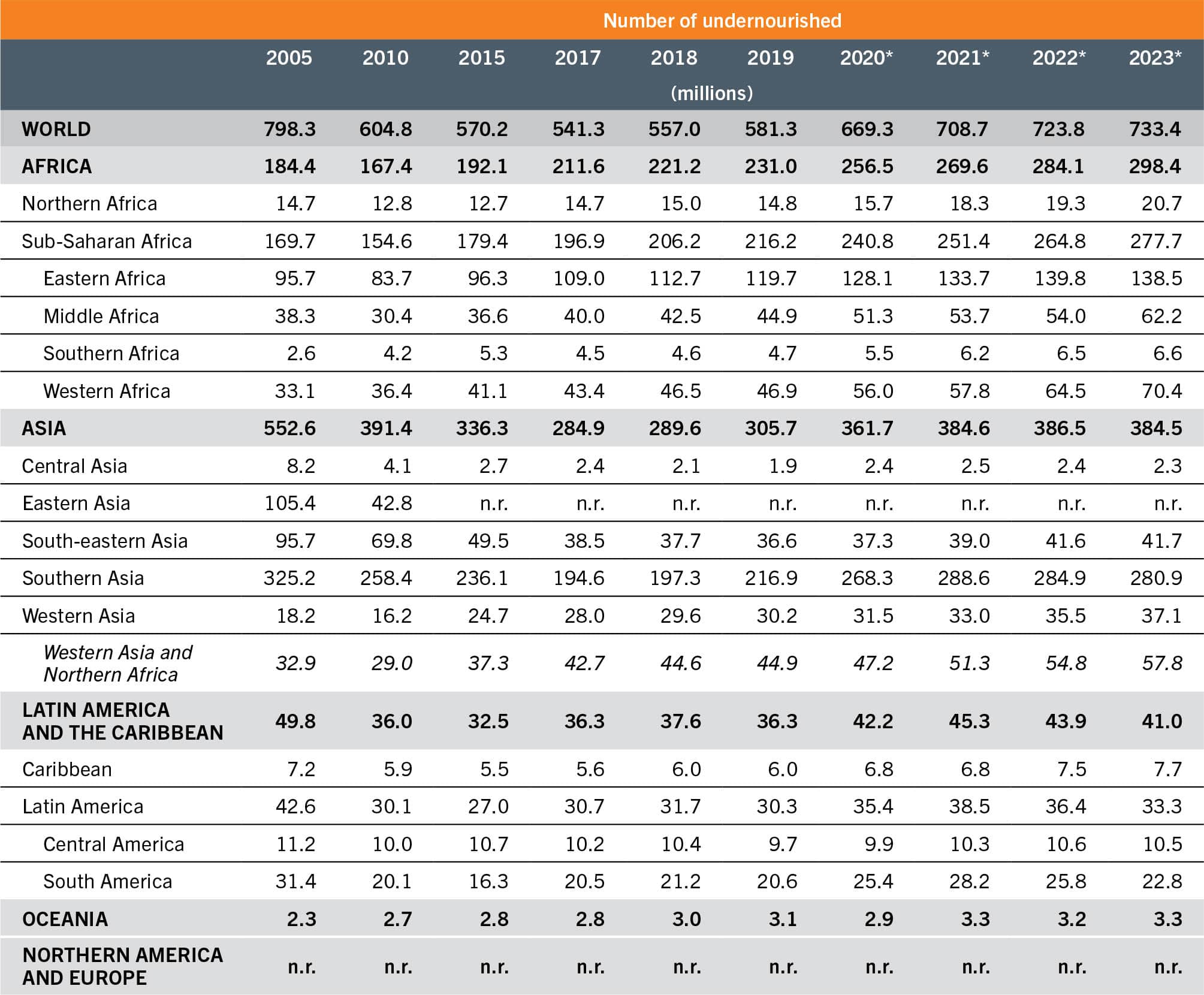
SOURCE: FAO. 2024. FAOSTAT: Suite of Food Security Indicators. [Accessed on 24 July 2024]. https://www.fao.org/faostat/en/#data/FS. Licence: CC-BY-4.0.
FIGURE 2 Progress was made towards reducing hunger in some subregions of Asia and in Latin America, but hunger is still on the rise in Western Asia, the Caribbean and most subregions of Africa
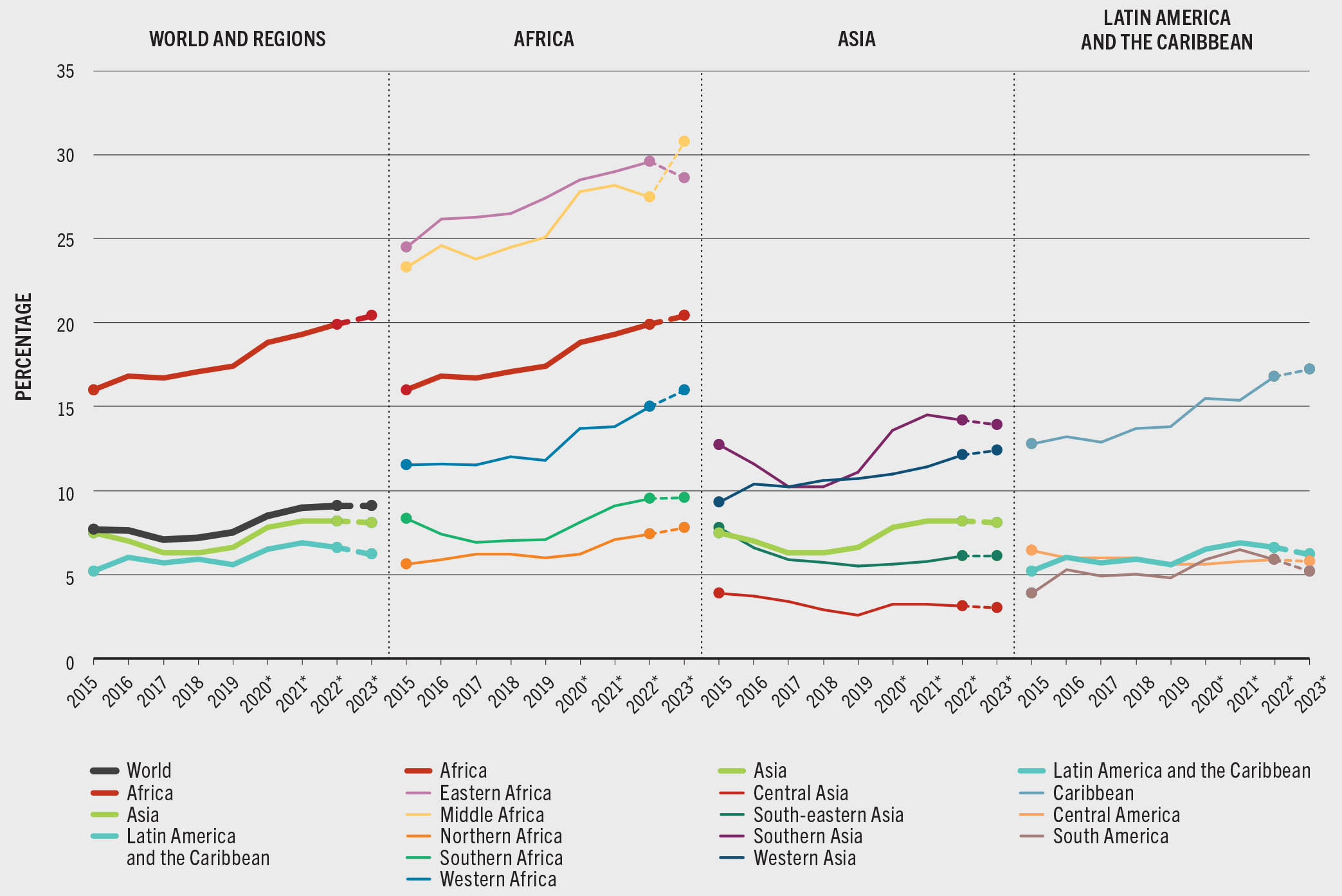
SOURCE: FAO. 2024. FAOSTAT: Suite of Food Security Indicators. [Accessed on 24 July 2024]. https://www.fao.org/faostat/en/#data/FS. Licence: CC-BY-4.0.
In Africa, hunger has been rising steadily since 2015. More than one person out of five living in Africa may have faced hunger in 2023. Hunger increased in most subregions of Africa from 2022 to 2023, with the exception of Eastern Africa and Southern Africa. After having risen steadily since 2015, the PoU in Eastern Africa fell by 1 percentage point in 2023 to 28.6 percent (138.5 million people). Still, nearly half of the people facing hunger in Africa in 2023 live in this subregion. In Southern Africa, the PoU remained relatively unchanged from 2022 to 2023 after three consecutive years of increases. In Middle Africa, on the other hand, the PoU rose sharply from 2022 to 2023, increasing by 3.3 percentage points – the largest percentage-point increase in any subregion of the world – to reach 30.8 percent (62.2 million people) in 2023. The situation also deteriorated in Western Africa, where the PoU rose sharply from 2019 to 2020 followed by a smaller increase in 2021, and then rose faster again for two consecutive years, reaching 16.0 percent (70.4 million people) in 2023. Hunger also increased, albeit more slowly, in the subregion with the lowest PoU in the continent, Northern Africa, affecting 7.8 percent of the population (20.7 million people) in 2023.
The trend in hunger in Asia mirrored that at the global level, characterized by a sharp increase from 2019 to 2021, followed by two years of virtually no change, with 8.1 percent of the population still facing hunger in 2023.
In Central Asia, following an increase from 2.6 percent in 2019 to 3.2 percent in 2020, the PoU decreased slightly in subsequent years to 3.0 percent in 2023. In South-eastern Asia, the PoU increased slowly from 5.5 percent in 2019 to 6.1 percent in 2022 and remained unchanged in 2023. In Southern Asia, encouraging progress was seen for two years in a row. Following a sharp rise from 2019 to 2021, the PoU decreased from 14.5 percent in 2021 to 13.9 percent in 2023 – the equivalent of 7.7 million fewer people facing hunger. In contrast, the situation continued to deteriorate in Western Asia, where hunger has been on the rise since 2015, reaching 12.4 percent in 2023.
In Latin America and the Caribbean, the two-year rise in hunger in the wake of the COVID-19 pandemic mirrored the global trend, but the recovery has been considerably stronger. After increasing from 5.6 percent in 2019 to 6.9 percent in 2021, the PoU fell for two consecutive years, reaching 6.2 percent in 2023 – a decrease equivalent to 4.3 million people in two years, driven mainly by improvements in South America. The progress is encouraging, although the PoU is still far above pre-pandemic levels.
At the same time, there is a notable disparity in progress at the subregional level, with hunger affecting a much larger proportion of the population, and rising, in the Caribbean. The PoU in the Caribbean was more than three times that in Latin America in 2023, and it showed a marked increase from 15.4 percent in 2021 to 17.2 percent in 2023. This contrasts with the trend in Central America, where the PoU increased only slightly from 5.6 percent in 2019 to 5.9 percent in 2022, and then showed a marginal decline in 2023. The most progress has been made in South America, where the PoU fell for two consecutive years by a total of 1.3 percentage points, down to 5.2 percent in 2023, after increasing sharply from 4.8 percent in 2019 to 6.5 percent in 2021, in the wake of the pandemic. That amounts to 5.4 million fewer people facing hunger in South America in 2023 compared to 2021.
When considering these results, it is also important to keep in mind the deteriorating food insecurity situation in countries affected by evolving humanitarian crises which may not be fully reflected in the PoU nowcast for 2023 (see Box 2).
BOX 2Deepening humanitarian crises increase acute food insecurity and threaten the right to adequate food in many places in the world
During the preparation of this edition of The State of Food Security and Nutrition in the World, deepening humanitarian crises continued to seriously erode food security and the realization of the right to adequate food in many countries. To inform decision-makers about this evolving situation, the Global Report on Food Crises1 details the acute food insecurity in a set of countries that are currently exposed to food crisis situations. Both The State of Food Security and Nutrition in the World and the Global Report on Food Crises are multipartnership efforts that provide international analyses of food security, but readers should be aware of their different objectives and geographical scope, as well as their reliance on distinctly different data and methodologies for their analyses.
One important distinction is that, by reporting on SDG 2 indicators, The State of Food Security and Nutrition in the World has the broad objective of monitoring chronic food insecurity – defined as food insecurity that persists over time, largely due to structural causes – in all countries, on a regular basis. The focus of the Global Report on Food Crises, on the other hand, is on acute food insecurity, which refers to any manifestation of food insecurity at a specific point in time that is of a severity that threatens lives, livelihoods or both, regardless of the causes, context or duration. Analyses of acute food insecurity reported in the Global Report on Food Crises are based mainly on the Integrated Food Security Phase Classification/Cadre Harmonisé (IPC/CH), and they differ considerably from those that inform the SDG indicators.2 Since timeliness is of the essence in crisis situations, IPC/CH rapid assessments are conducted by local teams of analysts through a consultative process among the main food security partners in the country, including government counterparts, aimed at finding convergence among all pieces of sometimes partial available evidence, including data from official and non-official sources commonly collected and used by the international humanitarian community.
According to the Global Report on Food Crises 2024, nearly 282 million people faced high levels of acute food insecurity in the 59 food-crisis countries/territories that were included in the analysis in 2023.* The five countries with the largest numbers of people facing high levels of acute food insecurity were, in descending order, the Democratic Republic of the Congo, Nigeria, the Sudan, Afghanistan and Ethiopia, while the countries with the largest share of the analysed population facing high levels of acute food insecurity were Palestine (Gaza Strip), South Sudan, Yemen, the Syrian Arab Republic and Haiti. One hundred percent of the population of the Gaza Strip faced high levels of acute food insecurity, as did more than half of the people living in South Sudan, Yemen and the Syrian Arab Republic, and nearly half the population of Haiti.
Over 705 000 people in five countries/territories** were projected to be facing Catastrophe (IPC/CH Phase 5) levels of acute food insecurity in 2023, most of them (576 000) in the Gaza Strip. The Gaza Strip became the most severe food crisis since IPC assessments were first conducted. By late 2023, the entire population of 2.2 million was classified as facing Crisis conditions or worse (IPC Phase 3 or above), and 80 percent of the population was internally displaced. An IPC Special Brief on Gaza3 dated 18 March 2024 warned of an imminent risk of famine, with more than a quarter of the population facing Catastrophe (IPC Phase 5) levels of acute food insecurity, which at that time was projected to expand to threaten half the population – 1.1 million people – by July 2024 if hostilities and restricted access to humanitarian aid continued.
A surge in conflict in the Sudan also contributed to extraordinarily high levels of acute food insecurity, with more than 20 million people facing Crisis conditions or worse (IPC Phase 3 or above) during the lean season in June–September in 2023. The Sudan became the world’s largest internal displacement crisis and had the largest number of people in the world facing Emergency (IPC Phase 4) levels of acute food insecurity – 6.3 million.
Escalating conflict, violence and internal displacement also fuelled a worsening food crisis in Haiti, where nearly 5 million people, or half the population, faced Crisis levels of acute food insecurity or worse (IPC Phase 3 or above), including 1.8 million facing Emergency (IPC Phase 4) levels during the lean season in March–June 2023.
In South Sudan, an estimated 7.8 million people – 63 percent of the population – were facing high levels of acute food insecurity (IPC Phase 3 or above) during the lean season in April–July 2023, including 2.9 million in Emergency (IPC Phase 4) and 43 000 in Catastrophe (IPC Phase 5) categories. Nearly 13 million people in the Syrian Arab Republic and 18 million in Yemen faced high levels of acute food insecurity.
These are some of the most serious humanitarian crises in the world that are posing daunting challenges for the realization of the right to adequate food. Humanitarian aid, including in the form of emergency agriculture, nutrition and food assistance, is urgently needed, together with an end to the hostilities, access to populations in need, and rebuilding of essential infrastructure and institutions crucial for guaranteeing people’s livelihoods and access to basic necessities. The seeds of future peace, food security and shared prosperity must be planted today.
Towards ending hunger (SDG Target 2.1): projections to 2030
As in previous editions of this report, an exercise was conducted to project how many people may be facing hunger in 2030 based on what can be inferred from available forecasts of fundamental demographic, agricultural productivity and economic variables. The projections were obtained by separately projecting each of the parameters that inform the model used to estimate the PoU (see Supplementary material to Chapter 2).
Trajectories are presented under two scenarios: “current prospects”, which aims to capture current projections of the PoU in 2030 based on the world economic prospects presented in the April 2024 edition of the International Monetary Fund World Economic Outlook database;5 and “projections before COVID-19 pandemic”, calibrated to reflect the situation of the world economy before the pandemic, as described by the World Economic Outlook published in October 2019.6
The current scenario shows that 582 million people, or 6.8 percent of the global population, will be chronically undernourished in 2030, pointing to the immense challenge of achieving SDG 2 (Zero Hunger) (Figure 3). This is about 130 million more undernourished people than in the “projections before COVID-19 pandemic” scenario.
FIGURE 3 Projected numbers of undernourished indicate that the world is far off track to achieve Zero Hunger by 2030
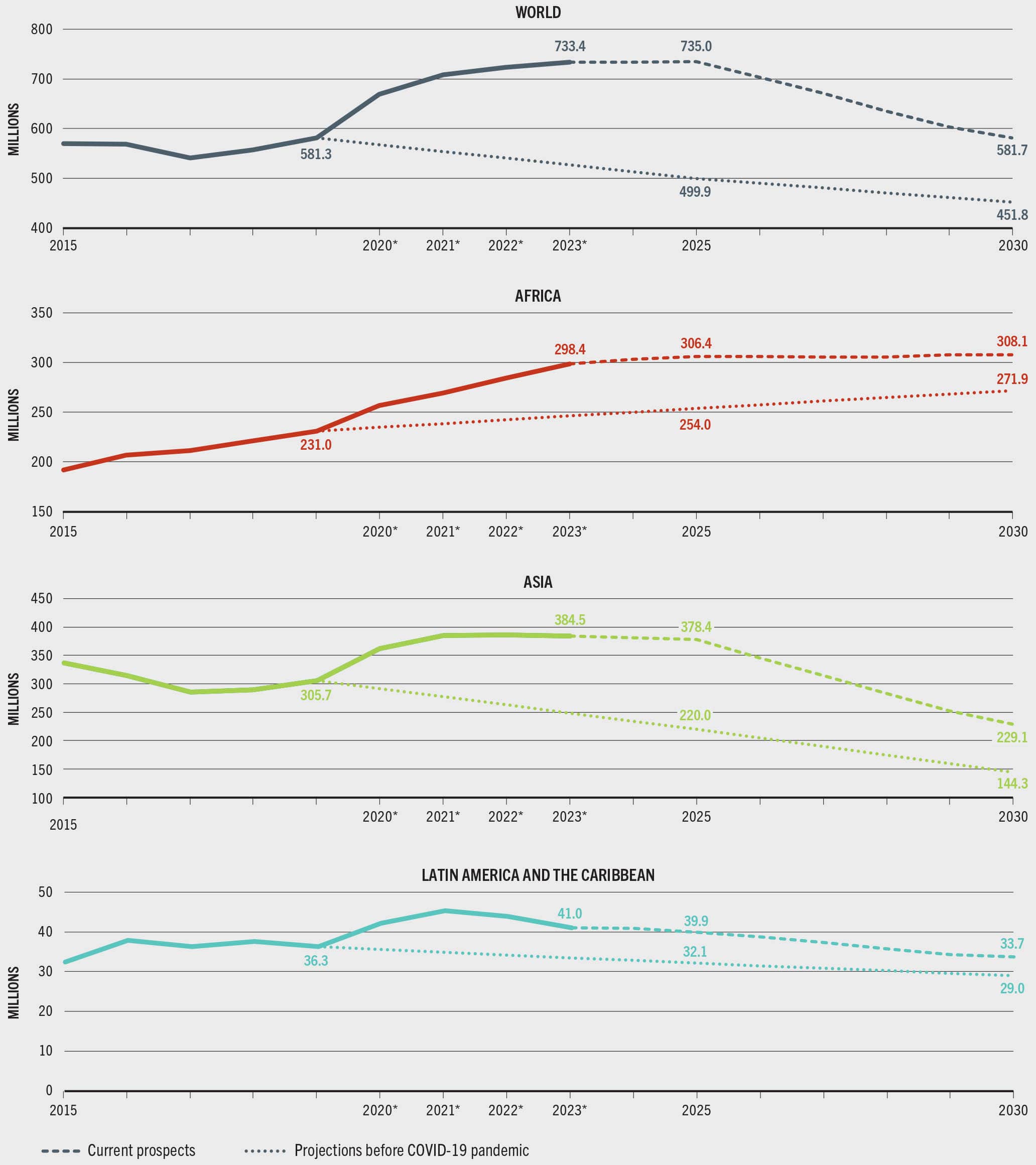
SOURCE: Authors’ (FAO) own elaboration.
Figure 3 also shows how the situation is currently expected to evolve in Asia, Africa, and Latin America and the Caribbean. The different trajectories are evident, demonstrating that practically all progress in the fight against hunger is expected to be made in Asia, with a strong recovery in the second half of the decade, where the number of undernourished is projected to fall from the current 385 million to 229 million people by 2030, nearly halving the prevalence of undernourishment (4.8 percent by 2030). Latin America and the Caribbean will reduce chronic hunger at a slower pace, by 8 million people, and will bring the prevalence of undernourishment below 5 percent by 2030. These two regions contrast sharply with Africa, where it is projected that 10 million more people (18 percent of the population) will be facing chronic hunger by 2030. Without accelerated efforts and increased resource mobilization, under current prospects, the continent will only manage to stabilize the situation at the high level of hunger inherited from the last few years.
SDG Indicator 2.1.2 Prevalence of moderate or severe food insecurity in the population, based on the Food Insecurity Experience Scale
SDG Target 2.1 aims for a world free from hunger, but it also goes much further; it presents a vision of a world in which all people have access to safe, nutritious and sufficient food all year round. SDG Indicator 2.1.2 – the prevalence of moderate or severe food insecurity in the population, based on the FIES – tracks progress towards this more ambitious goal, which in essence is the realization of the right to adequate food for all.
New estimates show that the global prevalence of moderate or severe food insecurity based on the FIES still remains far above pre-COVID-19 pandemic levels, with little change in four years (Figure 4). Since a sharp increase in food insecurity from 2019 to 2020 during the pandemic, levels have remained virtually unchanged. In 2023, an estimated 28.9 percent of the global population – 2.33 billion people – were moderately or severely food insecure, meaning they did not have regular access to adequate food. While the prevalence remained virtually unchanged from 2020 to 2023, the number of people facing moderate or severe food insecurity in the world nevertheless increased by more than 65 million, as the global population grew during that period (Table 3 and Table 4).
FIGURE 4 Food insecurity levels remained virtually unchanged globally from 2022 to 2023, with Latin America and the Caribbean being the only region showing notable reduction

SOURCE: FAO. 2024. FAOSTAT: Suite of Food Security Indicators. [Accessed on 24 July 2024]. https://www.fao.org/faostat/en/#data/FS. Licence: CC-BY-4.0.
TABLE 3Prevalence of food insecurity at severe level only, and at moderate or severe level, based on the Food Insecurity Experience Scale, 2015–2023

SOURCE: FAO. 2024. FAOSTAT: Suite of Food Security Indicators. [Accessed on 24 July 2024]. https://www.fao.org/faostat/en/#data/FS. Licence: CC-BY-4.0.
TABLE 4Number of people experiencing food insecurity at severe level only, and at moderate or severe level, based on the Food Insecurity Experience Scale, 2015–2023
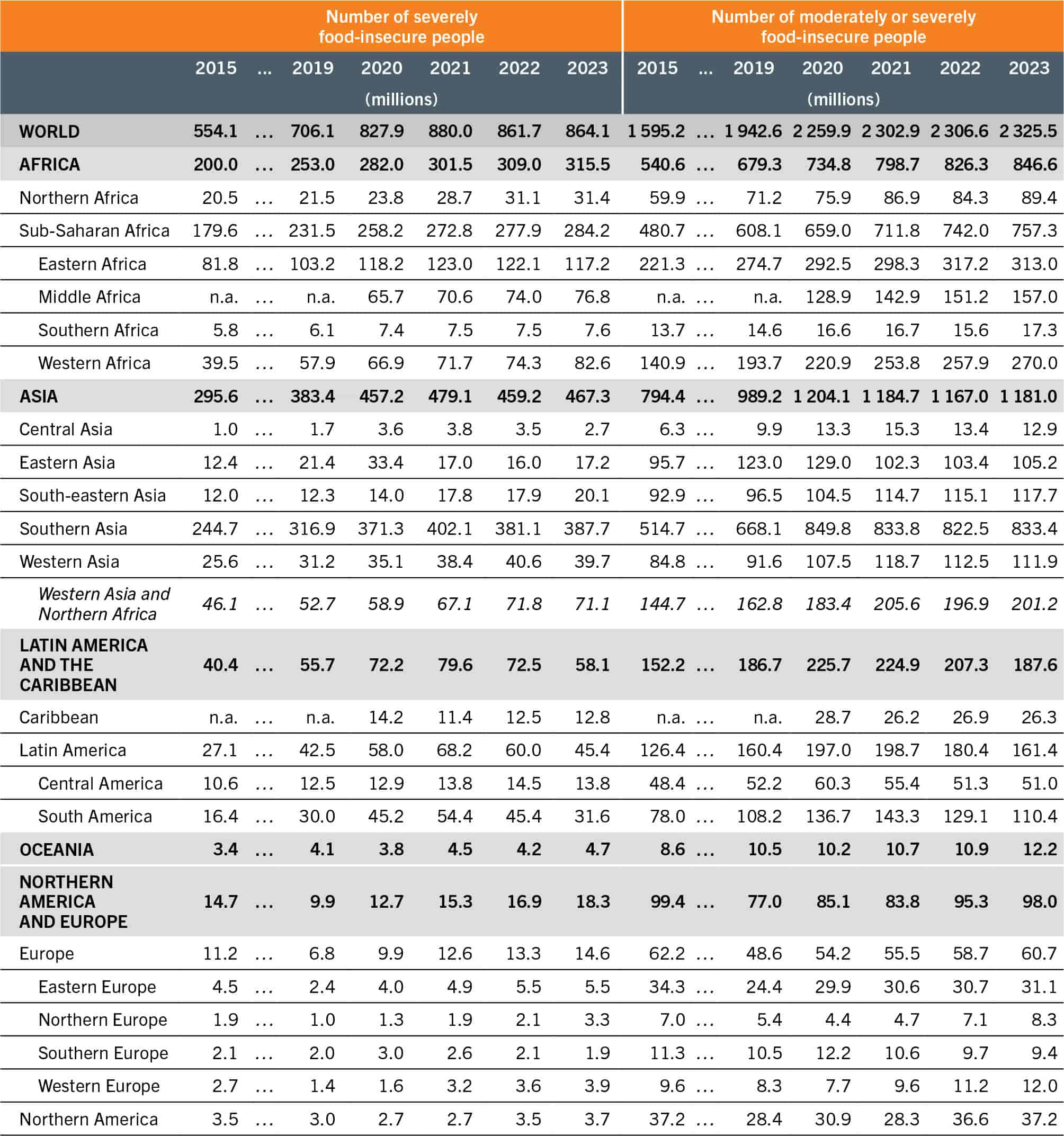
SOURCE: FAO. 2024. FAOSTAT: Suite of Food Security Indicators. [Accessed on 24 July 2024]. https://www.fao.org/faostat/en/#data/FS. Licence: CC-BY-4.0.
These estimates include 10.7 percent of the population – or more than 864 million people – who were severely food insecure, meaning they had run out of food at times during the year and, at worst, gone an entire day or more without eating. The prevalence of severe food insecurity at the global level rose from 9.1 percent in 2019 to 10.6 percent in 2020 and has remained stubbornly unchanged since then.
Comparing situations in the different regions of the world in 2023, Africa remains the region with the largest proportion of the population facing food insecurity. The prevalence of moderate or severe food insecurity in Africa (58.0 percent) is nearly double the global average, whereas in Asia, Latin America and the Caribbean, and Oceania, the prevalence is closer to and slightly below the global estimate – 24.8, 28.2 and 26.8 percent, respectively. From 2022 to 2023, food insecurity at moderate or severe levels remained virtually unchanged in Africa and Asia, while it worsened in Oceania and, to a lesser extent, in Northern America and Europe. In contrast, notable progress was made in the Latin American and Caribbean region (Table 3, Table 4 and Figure 4).
In Africa, 58.0 percent of the population was moderately or severely food insecure in 2023, and 21.6 percent faced severe food insecurity, although the differences between subregions were notable. Middle Africa had the highest prevalence of moderate or severe food insecurity (77.7 percent, or 157 million people), making it the subregion with the highest level in the world. It is followed by Eastern Africa (64.5 percent, or 313 million people) and Western Africa (61.4 percent, or 270 million people). One-quarter of the population of Southern Africa (17.3 million people) and more than one-third of Northern Africans (89.4 million people) were affected by moderate or severe food insecurity in 2023.
Middle Africa is also the subregion with the highest level of severe food insecurity in Africa and in the world – 38.0 percent in 2023. In Eastern Africa, 24.2 percent of the population is severely food insecure, followed by Western Africa (18.8 percent), Northern Africa (11.9 percent) and Southern Africa (10.9 percent).
From 2022 to 2023, the proportion of the population experiencing moderate or severe food insecurity increased at least marginally in most subregions of Africa, especially in Southern Africa, where it increased by 2.1 percentage points. However, improvements were seen in Eastern Africa – one of the most affected subregions – with a 2.6 percentage-point decrease from 2022 to 2023. That is equivalent to more than 4 million fewer people facing moderate or severe food insecurity in Eastern Africa in one year.
Focusing on severe food insecurity only, the prevalence remained relatively unchanged from 2022 to 2023 in Northern Africa, Middle Africa and Southern Africa, although it should be noted that, due to data availability, the trend in Northern Africa may not fully capture the impact of the rapidly deteriorating situation in the Sudan resulting from the conflict that erupted in April 2023 (see Box 2). Severe food insecurity decreased marginally in Eastern Africa in the same period, by 1.6 percentage points, while it rose slightly in Western Africa.
Turning to Asia, 24.8 percent of the population (1.18 billion people) were moderately or severely food insecure in 2023, and 9.8 percent (467.3 million) faced severe food insecurity. The majority live in Southern Asia, where 41.1 percent of the population, or 833.4 million people, faced moderate or severe food insecurity, close to half of whom were severely food insecure (387.7 million people, or 19.1 percent of the population in that subregion). In Western Asia, 37.5 percent (111.9 million) were moderately or severely food insecure and 13.3 percent (39.7 million) faced severe food insecurity. The prevalence of moderate or severe food insecurity was comparatively lower in Central Asia (16.6 percent, or 12.9 million people) and South-eastern Asia (17.1 percent, or 117.7 million people) and lowest in Eastern Asia (6.3 percent, equivalent to 105.2 million people). The proportion of the population facing severe food insecurity in these subregions was also much lower: 3.4 percent, 2.9 percent and 1.0 percent in Central Asia, South-eastern Asia and Eastern Asia, respectively.
Trends at the subregional level in Asia differ. In Eastern Asia, food insecurity levels remained virtually unchanged from 2021. In Southern Asia and South-eastern Asia, the prevalence of food insecurity at both levels of severity remained about the same from 2022 to 2023. There were signs of progress in Western Asia in the same period, although the prevalence of severe food insecurity was slightly higher in 2023 compared to 2021. Central Asia is the only subregion that has shown consistent progress since 2021, with food insecurity at both levels of severity decreasing for two years in a row; 2.4 million fewer people faced moderate or severe food insecurity in Central Asia in 2023 compared to 2021, and more than 1 million fewer people faced severe food insecurity.
Latin America and the Caribbean is the only region that made progress from 2022 to 2023 towards achieving SDG Target 2.1. The regional prevalence of food insecurity in the region decreased notably for the second year in a row, from 31.4 percent in 2022 to 28.2 percent in 2023 for moderate or severe food insecurity, and from 11.0 percent to 8.7 percent for severe food insecurity. That is equivalent to nearly 20 million fewer people facing moderate or severe food insecurity in 2023 compared to 2022, including more than 14 million fewer people facing severe food insecurity.
There are important subregional differences, however. In 2023, the prevalence of moderate or severe food insecurity in the Caribbean (58.8 percent) was more than double that of Central America (28.2 percent) and South America (25.1 percent). Changes from 2022 to 2023 were only marginal in Central America and in the Caribbean, although severe food insecurity rose marginally in the Caribbean since 2021. In contrast, encouraging progress was seen in South America. The prevalence of moderate or severe food insecurity fell for the second consecutive year, from 29.6 percent in 2022 to 25.1 percent in 2023 – the equivalent of 18.7 million fewer people facing moderate or severe food insecurity. The prevalence of severe food insecurity in South America also decreased markedly, from 10.4 percent in 2022 to 7.2 percent in 2023 – the equivalent of nearly 14 million fewer people.
Food insecurity appears to be on the rise in Oceania. Moderate or severe food insecurity rose steadily from 23.2 percent in 2020 to 26.8 percent in 2023, with a 2.7 percentage-point increase in the last year alone. The prevalence of severe food insecurity also increased marginally in the last year, from 9.3 percent in 2022 to 10.4 percent in 2023.
Food insecurity worsened slightly in Northern America and Europe between 2022 and 2023, though the difference remains within statistical margins of error. The prevalence of moderate or severe food insecurity in 2023 was 8.2 percent in Europe and 9.8 percent in Northern America, while 2.0 percent and 1.0 percent of the populations, respectively, faced food insecurity at severe levels.
Figure 5 presents a comparative overview of the scale and proportions of food insecurity globally and in the regions. Though the prevalence of moderate or severe food insecurity in Asia is about half that of Africa, Asia accounts for a larger share of the number of food-insecure people in the world – 1.18 billion in Asia compared with 847 million in Africa. In 2023, half of the 2.33 billion food-insecure people in the world lived in Asia, more than one-third in Africa, about 8 percent (188 million) in Latin America and the Caribbean, and about 4 percent (98 million) in Northern America and Europe. Some differences in the proportion of the food-insecure population that is facing food insecurity at severe levels are also evident. Severely food-insecure people account for the largest proportion of the total number of moderately or severely food insecure in Asia (about 40 percent), followed by Africa (37 percent), Latin America and the Caribbean (31 percent), and Northern America and Europe (18 percent).
FIGURE 5 The concentration and distribution of food insecurity by severity in 2023 DIFFERED greatly across the regions of the world
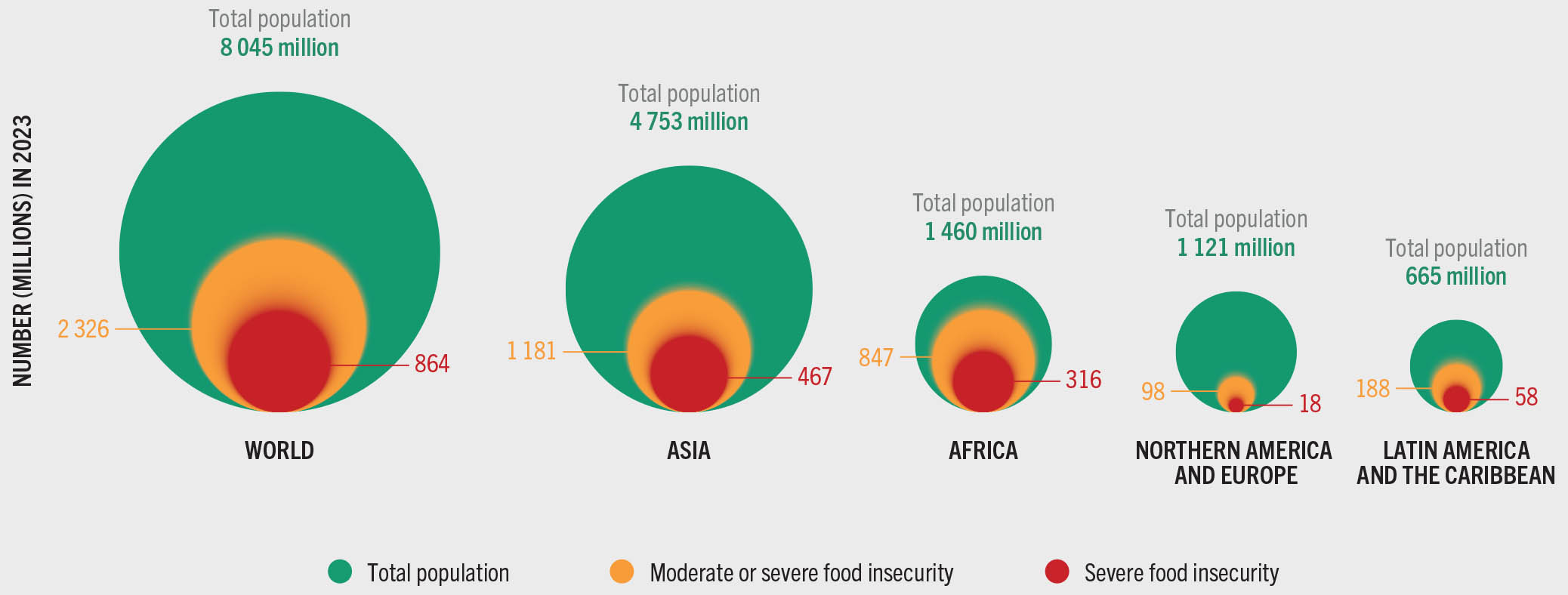
SOURCE: FAO. 2024. FAOSTAT: Suite of Food Security Indicators. [Accessed on 24 July 2024]. https://www.fao.org/faostat/en/#data/FS. Licence: CC-BY-4.0.
Differences in food insecurity across rural, peri-urban and urban areas and between men and women
One guiding principle of the vision put forth by the 2030 Agenda for Sustainable Development is to ensure that no one will be left behind. More detailed information about the food insecurity of different population groups helps monitor progress towards the realization of this vision. In this respect, FIES data collected by FAO can be used to produce relevant, disaggregated information on the food insecurity of specific population groups. First, as the data are georeferenced, differences among people living in rural, peri-urban and urban areas can also be analysed. Second, as the data are collected from individuals, it is possible to look at differences in food insecurity severity between men and women.
Georeferenced FIES data became available to FAO for the 2023 edition of this report when it was possible to present the first comparison of food insecurity in rural, peri-urban and urban populations at the global, regional and subregional levels.b FAO uses the Degree of Urbanization (DEGURBA) classification, an international standard, to distinguish among populations living in: i) rural areas; ii) towns and semi-dense areas (peri-urban areas); and iii) cities (urban areas), based on population density and size, in a globally comparable way.c, 7
Just as for 2022, results for 2023 show a pattern of decreasing food insecurity with an increasing degree of urbanization at the global level (Figure 6).d The prevalence of moderate or severe food insecurity was 31.9 percent in rural areas compared with 29.9 percent in peri-urban areas and 25.5 percent in urban areas. Globally and in all regions except Northern America and Europe, the prevalence of food insecurity, at both levels of severity, is consistently higher in rural areas than in urban areas. However, the prevalence in peri-urban areas relative to that in rural areas differs among the regions. In Africa and Asia, the prevalence of moderate or severe food insecurity is the same in peri-urban areas as in rural areas, and in Asia, severe food insecurity is slightly more prevalent in peri-urban areas. Northern America and Europe, considered together for this analysis, is the only region where people living in urban areas are more food insecure than those living in rural areas.
FIGURE 6 Globally and in most regions, the prevalence of food insecurity is higher in rural areas than in urban areas
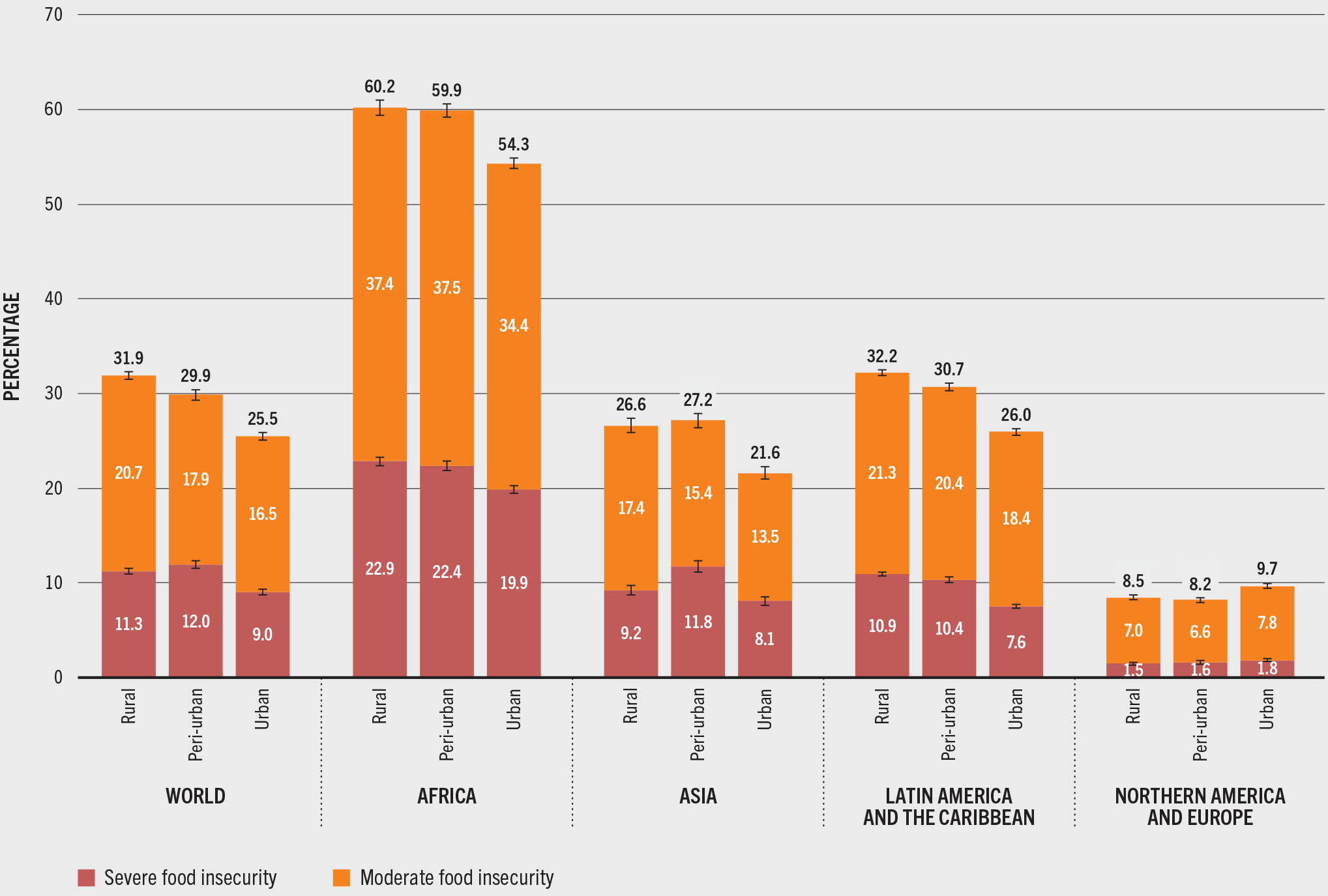
SOURCE: FAO. 2024. FAOSTAT: Suite of Food Security Indicators. [Accessed on 24 July 2024]. https://www.fao.org/faostat/en/#data/FS. Licence: CC-BY-4.0.
A comparison of the food insecurity status of men and women shows that the prevalence of food insecurity has remained consistently higher among women than among men, globally and in all regions, since data first became available in 2015. The gender gap widened considerably at the global level and in every region except Africa between 2019 and 2021 in the wake of the global COVID-19 pandemic, largely due to the disproportionate impact on women’s jobs and incomes and their larger burden of unpaid caregiving for out-of-school children and sick family members.8–10 At the global level, the gender gap in moderate or severe food insecurity jumped from a 1.4 percentage-point difference between men and women in 2019 to 3.6 percentage points in 2021, and for severe food insecurity, from a 0.6 percentage-point difference to 2.3 percentage points in the same period (Figure 7).e
FIGURE 7 The gender gap narrowed in most regions for two years in a row, but the prevalence of food insecurity has remained consistently higher among women than among men, globally and in all regions
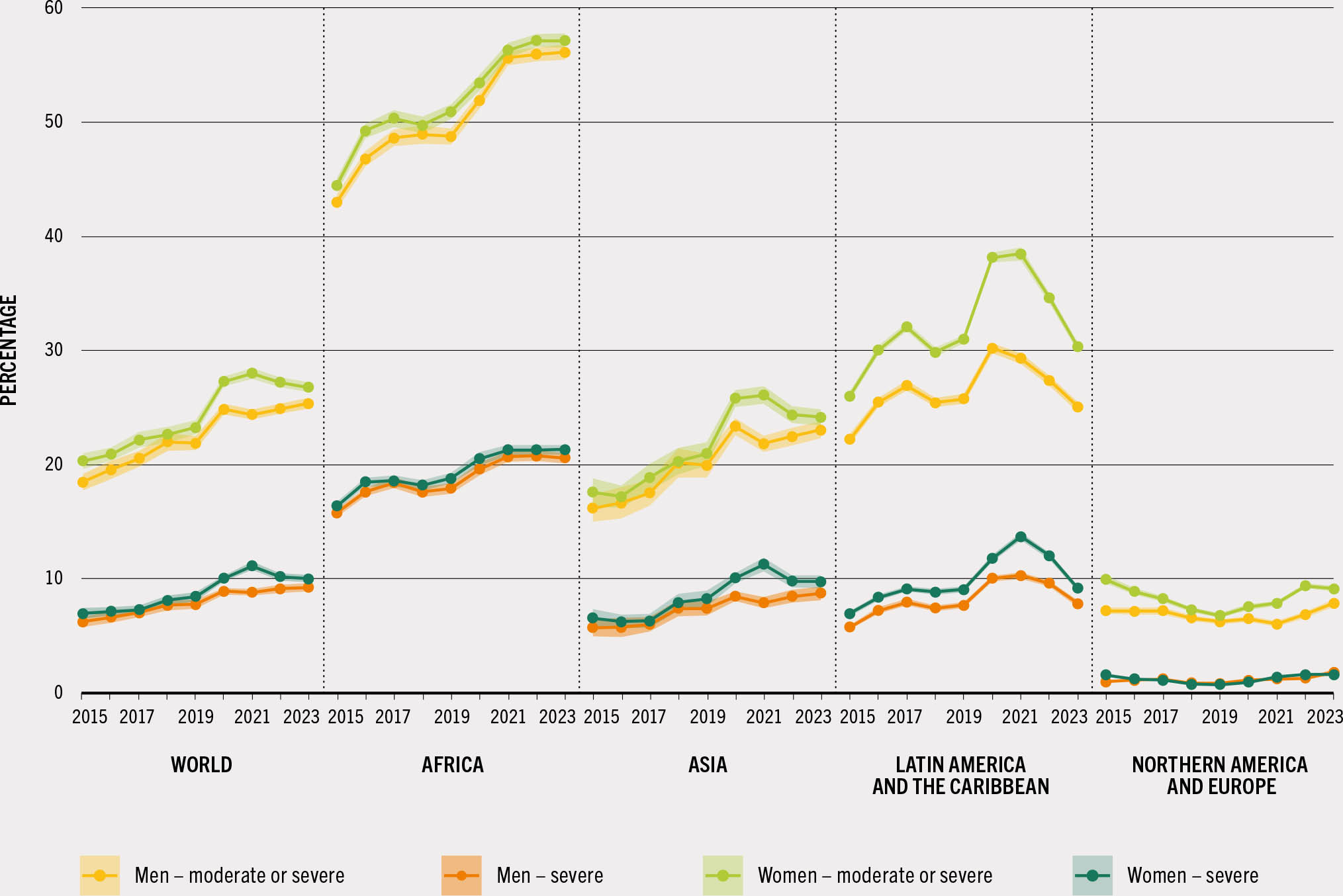
SOURCE: FAO. 2024. FAOSTAT: Suite of Food Security Indicators. [Accessed on 24 July 2024]. https://www.fao.org/faostat/en/#data/FS. Licence: CC-BY-4.0.
The gender gap narrowed markedly in 2022 as the pandemic and its unprecedented disruptions eased, and new data indicate that it continued to grow smaller in 2023. Globally, the percentage-point difference in the prevalence of moderate or severe food insecurity between men and women fell to 2.3 in 2022 and narrowed further to 1.3 in 2023. For severe food insecurity, the gap narrowed to 1 percentage point in 2022 and remained about the same in 2023.
It should be noted, however, that the shrinking gender gap is partially due to decreasing food insecurity among women concomitantly with rising levels among men for two consecutive years in Asia and in Northern America and Europe, driving the global trend.
The differences between men and women have grown smaller over the past two years in most regions. The gender gap for moderate or severe food insecurity in 2023 was close to 1 percentage point in all regions except Latin America and the Caribbean, where it was 5.2 percentage points – 30.3 percent of women were moderately or severely food insecure compared with 25.1 percent of men. For severe food insecurity, the gap was 1.4 percentage points for Latin America and the Caribbean compared with about 1 percentage point or less in the other regions.
Research based on FIES data collected by FAO has shown that women are more affected by food insecurity even when taking income, education level and demographic factors into account, suggesting that prevailing gender norms and women’s limited access to resources are key factors.10
This analysis, based on data collected using the FIES, shows the importance of collecting food security data in surveys designed to provide disaggregated information on the food insecurity of different population groups of interest. In the same way, when FIES data are collected in the same survey together with other relevant information, the results can also shed light on the potential causes and consequences of food insecurity. For example, past editions of this report have presented analyses of the association between food insecurity and different forms of malnutrition11 as well as diet.12 There are multiple pathways whereby the experience of food insecurity may contribute to various forms of malnutrition, but the main ones pass through diet.11 For this reason, it is important to enhance our understanding of how food insecurity, including moderate levels of severity, may be associated with diets. However, the collection of food consumption data in a way that allows for the comparison of diets across countries and cultures is a daunting challenge, and several initiatives are currently underway to meet this challenge. One such initiative is collecting dietary data in many of the same surveys that collect FIES data, providing the unique opportunity to examine the association between food insecurity and diet (Box 3).
BOX 3IS FOOD INSECURITY SEVERITY ASSOCIATED WITH THE PROPERTIES OF A HEALTHY DIET? PRELIMINARY EVIDENCE FROM 28 COUNTRIES
Healthy diets are achieved by consuming a diversity of foods that provide adequate nutrients and bioactive compounds important for health, a balanced intake of macronutrients, and a moderation of foods and beverages that increase the risk of diet-related non-communicable diseases (NCDs), including those that are high in unhealthy fats, free sugars and/or salt and/or which contain non-sugar sweeteners, and which are often highly processed.13–19 Although the concepts of food security and healthy diets are intimately linked, the relationship between them is not straightforward.
While it might seem intuitive that food-insecure people are less likely to achieve a healthy diet, this link is not straightforward because of a plethora of factors that differ across contexts, such as those related to food environments, consumer behaviour, and the cost and affordability of a healthy diet. For example, food insecurity has been found to be associated with lower consumption of all types of foods and higher share of dietary energy from staple foods in some contexts, while in others it has been found to be associated with lower consumption of nutritious foods and higher consumption of energy-dense foods high in unhealthy fats, sugars and salt.20
Food insecurity, therefore, may affect diets in a variety of ways that could potentially contribute to several forms of malnutrition including undernutrition (stunting, wasting and micronutrient deficiencies) but also to overweight and obesity.11, 21 However, because most studies collect food insecurity and dietary intake data using different samples, data collection modalities and analysis approaches, thus hampering comparison of the results, it has been difficult to explore the associations between the severity of food insecurity and the healthiness of diets across countries.
FAO has been collecting food security data annually using the Food Insecurity Experience Scale (FIES) since 2014 through the Gallup© World Poll (GWP). Beginning in 2021, new data on diet quality have also been collected in the GWP in a growing number of countries using the Diet Quality Questionnaire (DQQ), providing an opportunity to explore the associations between food insecurity and properties of a healthy diet in a comparable way across countries. The DQQ and several novel dietary metrics were developed by the Global Diet Quality Project, a collaborative effort of Gallup©, Harvard University and the Global Alliance for Improved Nutrition.22
A well-established indicator that can be derived from DQQ data is the proportion of women aged 15 to 49 years who have achieved “Minimum Dietary Diversity for Women” (MDD-W), meaning they consumed foods from at least five out of ten food groups (indicating a minimally acceptable level of dietary diversity).23
Data collected using the DQQ also include a novel measure that aims to reflect the dietary principle of moderation, namely through the “NCD-Risk” indicator.* Additionally, the DQQ permits the exploration of the consumption of specific food groups, such as zero vegetable or fruit (ZVF) and animal-source food (ASF), as well as a measure of the consumption of food groups related to lower risks of diet-related NCDs (“NCD-Protect” indicator*).
Both the FIES survey module and the DQQ were implemented in the GWP, with both types of data collected from the same respondents aged 15 years and above, in 28 countries in 2021 and 2022.** Pooled data from these 28 countries were used to examine the association*** between the severity of food insecurity, based on the FIES, and adherence to the properties of a healthy diet, based on MDD-W and novel metrics derived from the DQQ.
Greater severity of food insecurity was associated with lower dietary diversity among women aged 15 to 49 years in these 28 countries (Figure A). Less than 50 percent of severely food-insecure women achieved MDD-W, while over 77 percent who were food secure or mildly food insecure achieved MDD-W. This association held after controlling for income level, education, gender, urban–rural residence and country of residence of the respondents.
FIGURE A The percentage of the population of women aged 15 to 49 years in 28 countries achieving MINIMUM DIETARY DIVERSITY FOR WOMEN by food security status
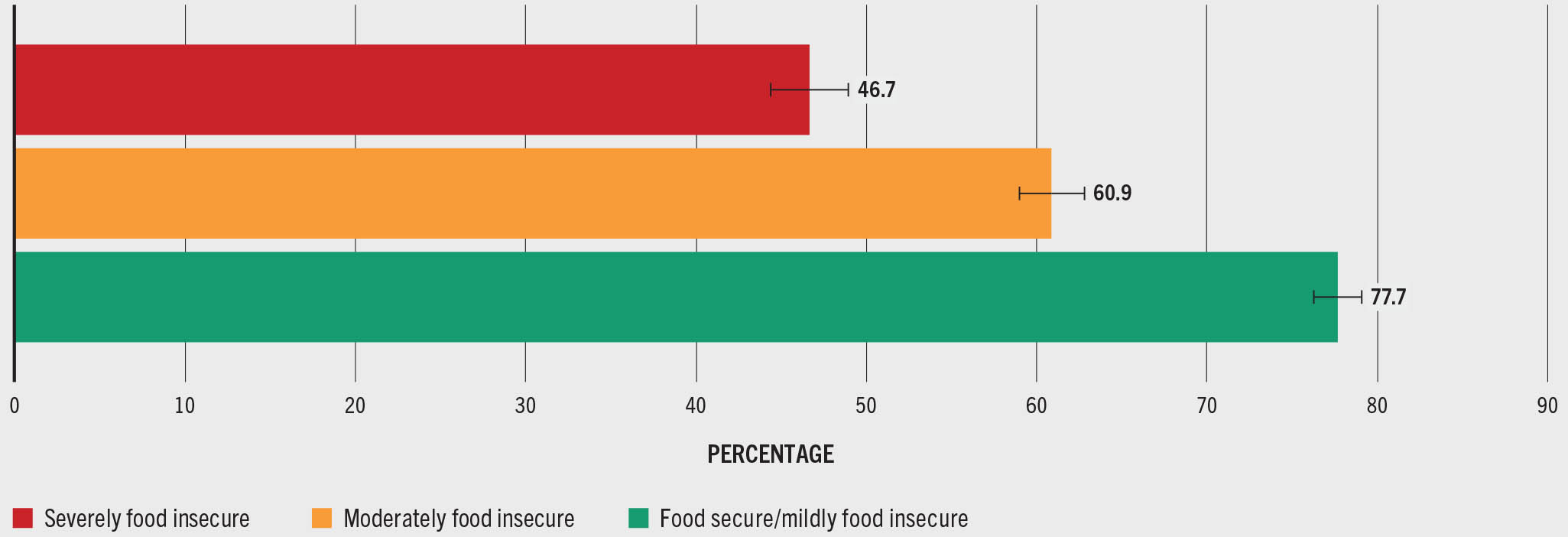
Expanding the analysis to the entire adult population (both men and women) in the 28 countries, and controlling for the same respondent characteristics mentioned above,*** greater severity of food insecurity was associated with lower odds of consuming ASF and higher odds of consuming ZVF. It was also associated with lower odds of consuming a diet that protects against NCDs (based on the NCD-Protect indicator) as well as lower odds of consuming foods linked with greater risk of NCDs (based on the NCD-Risk indicator). That is, the more food insecure men and women were, the fewer healthy and unhealthy food groups they consumed. In isolation, the finding that greater food insecurity was associated with lower consumption of unhealthy food groups may give the impression that food insecurity was associated with better adherence to dietary moderation. However, in this pooled sample of data from 28 countries, 21 of which were low- or lower-middle-income countries, greater severity of food insecurity suggested a general lack of access to (or availability of) all food groups, healthy as well as unhealthy.
Some UN agencies are already routinely collecting both FIES and MDD-W data in the same surveys. Since 2022, the International Fund for Agricultural Development (IFAD) has been collecting MDD-W data through surveys in several countries, including Cameroon, Cabo Verde, Nepal and Türkiye, for project reporting. In addition, FIES data are used for the Impact Assessment Corporate Reporting Programme to measure the attributable impact of IFAD’s investment projects in each replenishment period.
Healthy diets and the SDGs
Ensuring healthy diets is key to achieving SDG 2 and a prerequisite for achieving many other goals. However, diets are not currently captured by any of the SDG 2 indicators that monitor the prevalence of undernourishment (hunger), moderate or severe food insecurity based on FIES, and four indicators of nutritional status (stunting, wasting and overweight among children under five years of age, and anaemia among women aged 15 to 49 years).24 The absence of an indicator of diet quality in the SDG indicator framework therefore represents a gap in the monitoring of progress towards the 2030 Agenda for Sustainable Development.
To address this issue, a group of Member States (Bangladesh, Brazil, Malawi and Switzerland), with the support of FAO, IFAD, UNICEF, WFP and WHO have recommended that the “Prevalence of Minimum Dietary Diversity” (among women and children) be included as an SDG 2 indicator through the 2025 Comprehensive Review. The inclusion of an indicator on diets would help close this important gap in the final stretch to 2030 and help inform the actions needed not just to deliver Zero Hunger, but to ensure the good nutrition, health, and development of populations on which all SDGs rely.
The lack of improvement in food security and the uneven progress in the economic access to healthy diets cast a shadow over the possibilities of achieving Zero Hunger in the world, six years away from the 2030 deadline. There is the need to accelerate the transformation of our agrifood systems with greater resilience to the major drivers, addressing inequalities to ensure that healthy diets are affordable and available to all.



